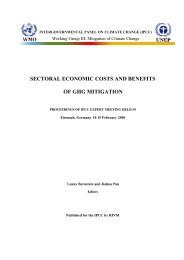Pacific Islands Environment Outlook - UNEP
Pacific Islands Environment Outlook - UNEP
Pacific Islands Environment Outlook - UNEP
Create successful ePaper yourself
Turn your PDF publications into a flip-book with our unique Google optimized e-Paper software.
50<br />
ALTERNATIVE POLICY OPTIONS<br />
These gaps combine with a general weakening of<br />
enforcement through traditional and community<br />
structures as a result of continuing urban migration and<br />
increasing pressure for cash income at the village level.<br />
From the analysis above and consistent with the recent<br />
submission to the United Nations Commission on<br />
Sustainable Development (Forum Secretariat 1999b),<br />
effort is clearly required to:<br />
●<br />
●<br />
●<br />
●<br />
●<br />
●<br />
●<br />
●<br />
further increase capacity in the public sector to deal<br />
with environmental issues, in particular within<br />
departments involved in planning and resource use<br />
(e.g. agriculture, fisheries, tourism, finance);<br />
provide basic infrastructure, in some cases in<br />
combination with appropriate regulatory and<br />
economic mechanisms and enforcement/<br />
implementation of existing legislation;<br />
promote effective partnerships among all<br />
stakeholders, in particular local communities, NGOs<br />
and the private sector;<br />
further develop skills training, and basic and higher<br />
education opportunities for sustainable development;<br />
build upon efforts to integrate environment and<br />
development within PICs. Efforts to implement<br />
economic and public sector reform, along with the<br />
work of the SPOCC, provide opportunities to do this.<br />
Ideally this integration would continue to promote a<br />
holistic approach to island development, to make<br />
most effective use of the capacity within countries<br />
and regionally;<br />
gather basic information that establishes baselines<br />
or benchmarks and ongoing systems for monitoring<br />
and assessment of key indicators that can be used to<br />
assist decision-making and measure progress in<br />
implementing sustainable development. Also<br />
essential are effective communications and<br />
networking systems to share that information;<br />
make explicit the links between health, population<br />
and the environment, including issues of gender, as<br />
contained in the Port Vila (Population) and Yanuca<br />
Island Declarations and the Rarotonga Agreement<br />
(Healthy <strong>Islands</strong>);<br />
compile a composite vulnerability index of<br />
economic as well as ecological/environmental<br />
parameters, as was highlighted in the Barbados<br />
Programme of Action. The 1998 South <strong>Pacific</strong><br />
Forum agreed the index should be included among<br />
criteria for determining Least Developed Country<br />
status and for deciding eligibility for concessional<br />
aid and trade treatment. The <strong>Pacific</strong> region is now<br />
engaged in the development of the ecological<br />
aspects of a vulnerability index and will contribute<br />
to the efforts of UNDP, the World Bank and the<br />
Commonwealth Secretariat to develop a composite<br />
vulnerability index.<br />
In this context, and as recommended by the Regional<br />
Consultation on the <strong>Pacific</strong> <strong>Islands</strong> <strong>Environment</strong><br />
<strong>Outlook</strong> held in Apia, Samoa, on 9–10 November 1998,<br />
a useful focus for the following discussion of alternative<br />
policy options is the reduction of the impacts of human<br />
population and the improvement of public health.<br />
Population and health<br />
Population experts have focused on these interrelated<br />
issues of the human environment in the <strong>Pacific</strong>. They<br />
are succinctly summarized in a publication prepared by<br />
SPC for the International Conference on Population and<br />
Development, held in Cairo in 1994:<br />
‘<strong>Environment</strong>al degradation is most evident where<br />
populations and economic activity are concentrated<br />
together, particularly around towns, and where<br />
resources such as timber and minerals are being overexploited.<br />
Demand on resources has increased not<br />
simply because there are more people, but also because<br />
their individual requirements have increased. The<br />
seeming inexhaustibility of resources has until very<br />
recently encouraged people in the <strong>Pacific</strong>, as elsewhere<br />
in the world, in a short-sighted use of resources.’ (SPC,<br />
revised 1998)<br />
The estimated population growth rate of 2.2 per cent<br />
per annum is an average across the region and thus<br />
conceals these trends, as well as the considerable<br />
variations within the region. As noted, there are also incountry<br />
variations: Vanuatu, for example, has an urban<br />
population growth rate of 8 per cent per annum,<br />
whereas the national statistic is 2.4 per cent (SPC<br />
1998). The future outlook is complicated further by the<br />
fact that the low population growth figures for much of<br />
Polynesia are due in part to a continuing high level of<br />
migration to developed countries around the <strong>Pacific</strong><br />
Rim. When economic conditions deteriorate in those<br />
countries (which is the current situation), there is likely<br />
to be a fall in the rate of emigration.<br />
The governments and people of PICs have taken<br />
major initiatives in recent years to begin to articulate<br />
their urban development needs and priorities. Fiji is

















